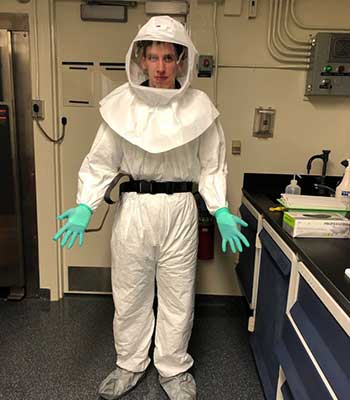As research across the university abruptly ramped down in March, essential COVID-19 research ramped up. Several Environment, Health, and Safety staff worked nearly around the clock to ensure U-M researchers were trained and ready to work in a biosafety level 3 (BSL3) laboratory.
Researchers working with COVID-19 (such as searching existing drugs for potential COVID-19 treatments) must work in a specialized BSL3 lab. According to the CDC, it is designed to contain “agents with a known potential for aerosol transmission that may cause serious and potentially lethal infections.”
The lab had been inactive for nearly 4 years and most researchers had little or no experience working in a BSL3 containment lab. So the EHS Biosafety team and partners across F&O quickly came together to bring the facility back online and prepare the research staff to work in a BSL3 laboratory setting.

To reactivate the facility, F&O staff in HVAC, Electrical Shop, Life Safety, and Moving and Trucking worked together to ensure the safety features were functioning properly.
Each research group that proposes to work with the virus that causes COVID-19 must submit a detailed protocol to the U-M Institutional Biosafety Committee. As part of the process, the EHS Biosafety team reviews each proposal to ensure all safety aspects have been effectively addressed.
Once the researchers have the approval to work in the BSL3 lab, EHS spends approximately 8 hours training each person. The training consists of instruction, practical exercises, and confirming the trainee’s understanding. So far, Janet Follo, Sheya Martin, Crystal O’Donnell, and Eric Robertson have trained 8 people from 3 different research groups and there are more in the queue.
“It’s amazing to be helping in this capacity,” Eric said. “It’s been rewarding to see people hit the ground running after we train them.” Sheya adds, “My coworkers, Crystal and Eric, have amazing attention to detail and we are all on the same page.”
New proposals for COVID-19 research continue to come in. The team provides its expertise to help the research community work safely as they search for more ways to combat COVID-19. “We are thrilled to be part of this important COVID research,” said Janet Follo, the team’s manager. “This has been a huge bright spot in these complicated times.”

